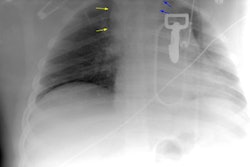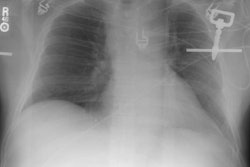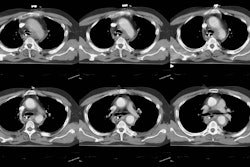J Nucl Med 2001 Mar;42(3):420-3
Lymphoscintigraphy and sentinel node localization in breast cancer patients:
a comparison between 1-day and 2-day protocols.
Yeung HW, Cody III HS, Turlakow A, Riedel ER, Fey J, Gonen M, Nunez R, Yeh SD,
Larson SM.
The purpose of this study was to compare the results of isotope injection the
morning of surgery (1-d protocol) with isotope injection the day before surgery
(2-d protocol) in patients having sentinel lymph node (SLN) biopsy for breast
cancer. METHODS: The 1-d (protocol 1) and 2-d (protocol 2) protocols included
514 and 152 patients, respectively, treated contemporaneously by surgeons
experienced with the SLN biopsy technique. All had preoperative
lymphoscintigraphy (LSG) and SLN biopsy using both blue dye and (99m)Tc-sulfur
colloid. All patients had a single-site intradermal injection of unfiltered
(99m)Tc-sulfur colloid in 0.05 mL normal saline: 3.7 MBq (0.1 mCi) on the
morning of surgery for protocol 1 and 18.5 MBq (0.5 mCi) on the afternoon before
surgery for protocol 2. RESULTS: The patients in protocols 1 and 2 were
comparable in terms of age, tumor size, tumor location, histologic type, node
positivity, and frequency of a previous surgical biopsy. Comparing protocols 1
and 2, early (30 min) LSG images found the SLN equally often (69% vs. 68%).
Isotope identified the SLN equally often at surgery (93% vs. 97%) as did isotope
plus dye (98% vs. 99%). A comparable number of SLNs was found (2.5 vs. 2.8 per
axilla), and the concordance between isotope and dye in the SLN was also
comparable (97% vs. 95%). Late LSG images (at 2 h, possible only for protocol 2)
identified the SLN in significantly more patients compared with early images
(86% vs. 68%). CONCLUSION: With unfiltered (99m)Tc-sulfur colloid injected
intradermally, the results of SLN biopsy under the 1-d and 2-d protocols are
virtually identical. A 2-d protocol allows increased efficiency in scheduling,
both for nuclear medicine physicians and for the operating room, with no
compromise in the effectiveness of SLN mapping.



















